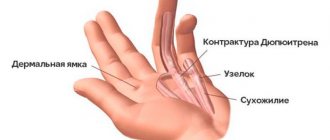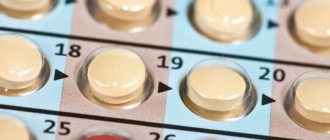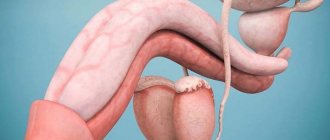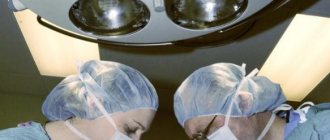Peyronie's disease (fibroblastic induration) is a male urogenital disease that is accompanied by curvature of the penis. The defect becomes noticeable when the penis is erect. Peyronie's disease is difficult to experience psychologically and is often accompanied by problems in sexual life.
If you are looking for a medical center where you can treat Peyronie's disease, visit the Federal Scientific and Clinical Center of the Federal Medical and Biological Agency in Moscow. Our doctors have extensive experience in performing such operations. After treatment, the cosmetic defect is eliminated, sexual function is completely restored, and physical discomfort caused by the curvature of the penis disappears.
You can find out more about how much surgery for Peyronie's disease costs below.
Causes of Peyronie's disease
The main cause of Peyronie's disease is micro- and macrotrauma to the penis, which can occur during sexual intercourse. At the site of injury, dense scars (plaques) form, causing deformation. There is also an autoimmune theory of the occurrence of this disease, in which the appearance of plaques is caused by an attack on the body’s own cells.
In addition, the following factors may influence the development of Peyronie's disease:
- dysfunction of the immune system;
- metabolic pathology;
- diabetes mellitus, gout;
- connective tissue diseases;
- atherosclerosis.
Prevention of Perioni's disease
Since the exact causes of the disease are still unknown, it is difficult to offer specific prevention of Peyronie’s disease. However, men are advised to adhere to a certain lifestyle to minimize the occurrence of the disease.
- Healthy lifestyle (healthy diet, exercise, regular checkups).
- Wear comfortable underwear and loose pants.
Article information
| Last update | April 21, 2021 |
| Next update | April 21, 2022 |
| Author | Potapov S.A. |
| Medical editor | Doctor Plekhanov A.Yu. |
Bibliography
- Guidelines on Penile Curvature; European Association of Urology (2015)
- Bilgutay AN, Pastuszak AW; Peyronie's Disease: a Review of Etiology, Diagnosis and Management. Curr Sex Health Rep. 2015 Jun 17(2):117-131. doi: 10.1007/s11930-015-0045-y.
- Gelbard MK, et al. The natural history of Peyronie's disease. J Urol 1990 144(6): p. 1376-9.
- Jarow JP, et al. Penile trauma: an etiologic factor in Peyronie's disease and erectile dysfunction. J Urol 1997 158(4): p. 1388-90.
Symptoms of Peyronie's disease
The main symptom of the disease is deformation of the penis during erection. Its deviation from the median axis can have varying degrees of severity; the penis can deviate to the right or left, as well as up or down. Seals appear under the skin of the organ - plaques, the palpation of which is painful. The patient may also experience a painful or weakened erection, or a decrease in the size of the penis due to its curvature.
With a mild degree of curvature, the patient may feel slight discomfort during sexual intercourse. With a pronounced degree (deviation of more than 50–60 degrees), sexual intercourse becomes impossible, as it causes sharp pain in the man in the genital area. Manifestations of Peyronie's disease tend to progress.
Stages of the disease
- Hidden. Pain and slight curvature of the penis during erection, signs of impaired blood flow.
- Initial. Moderate pain at rest and during erection, mild induration, moderate curvature of the penis during erection.
- Stabilization. Minor pain, clearly defined curvature, well-defined lump.
- Ultimate. No pain, hardening, Peyronie's disease similar to bone, pronounced curvature.
MAKE AN APPOINTMENT WITH AN ANDROLOGIST
Klokov Andrey Nikolaevich
Urologist-andrologist, doctor of the highest category
Make an appointment
How is surgery performed for Peyronie's disease?
Surgery is most often performed under general anesthesia and lasts about 2.5–3 hours. Postoperative sutures are made of absorbable material.
There are 3 options for surgical intervention:
- The curvature of the penis is eliminated by placing sutures in the projection of the plaque; the plaque itself is not removed. This operation is performed most often; after it, a slight shortening of the penis is possible, as the corpus cavernosum is shortened.
- Operation grafting. The plaque is completely excised, the lack of membrane is compensated by a patch made from the patient’s vein, buccal mucosa, or synthetic material.
- Penile prosthetics. Indicated for patients suffering from severe scarring and extreme erectile dysfunction. In this case, a special device is implanted into the body of the penis, controlled by a pump and causing an erection.
Surgery
It is rarely prescribed, since the result does not always meet the patient’s expectations. Surgery is not indicated for minor deformities of the penis. Some clinics perform not only correction of deformities, but also penile replacement, which leads to erectile dysfunction. We recommend the installation of grafts - a method of solving the problem of penile deformation without impairing erectile function and reducing its length. The graft can be bovine pericardium or saphenous vein. The effectiveness of the operation is 75-96%.
Preparing for surgery
Before the operation, the patient undergoes a comprehensive examination. He takes general blood and urine tests and consults a doctor who conducts an examination, performs palpation, identifies the degree and type of deformation of the penis, and determines the technique of performing the operation. If necessary, consultations with narrow specialists are prescribed.
To accurately diagnose the localization of plaques and their sizes, additional ultrasound Dopplerography of blood vessels, ultrasound, CT, and MRI can be performed. The cost of treatment for Peyronie's disease includes an initial examination and surgery; laboratory tests are not included in the price and are paid separately.
Diagnostics
As a rule, the doctor makes a verdict based on the patient’s complaints, palpation and general examination. Diagnostics involves:
- determining the location, density and size of plaques;
- establishing the possibility of erection;
- ascertaining the stage of the disease.
Instrumental research methods are also used.
- Ultrasound. The most effective method for assessing the structure, location and size of plaques. However, the method is completely useless if the disease is just beginning.
- X-ray. It is also advisable to resort to its help only in the later stages of Peyronie's disease. However, it helps to distinguish this disease from other problems of the penis.
- MRI of the penis. Another effective diagnostic tool that can tell not only about the indicators of the plaque, but also about the condition of the tissues surrounding it, and the development of inflammation. The use of MRI allows you to correctly determine the treatment program.
Rehabilitation after surgery
The duration of rehabilitation depends on the complexity of the operation. Simple operations are performed on an outpatient basis under local anesthesia. Immediately after the procedure, the patient can go home and recover in his usual conditions.
Complex operations are performed under general anesthesia, which requires a subsequent stay in the hospital for 2–3 days. During this period, analgesics are prescribed. If there are no complications, the patient is discharged after 3 days. The duration of rehabilitation can be 1–1.5 months; sexual activity can begin after postoperative wounds have healed.
Drugs
At the initial stages of development, surgical intervention is not always required; the pathology can be cured without surgery. A specialist may suggest the use of medications to relieve inflammation. In some cases, the doctor recommends taking vitamin E, colchicine and other medications.
This treatment is not always effective. If a positive result cannot be achieved, other methods of therapy are used - treatment with physiotherapeutic procedures or surgery, depending on the patient’s health condition.
Procedures
One of the procedures, UVT, allows you to soften plaques with low-intensity shock waves. With the help of iontophoresis, inflammation can be removed; the medicine is transferred to the affected area by small current discharges that the patient does not feel.
If the disease cannot be eliminated with medications and procedures, surgery may be prescribed.
Contraindications
The main contraindications to surgical treatment are:
- severe anemia;
- chronic diseases in a state of decompensation (heart and pulmonary failure, cirrhosis of the liver);
- exacerbation of chronic diseases;
- serious psychoneurological disorders;
- obesity 4 degrees;
- uncompensated diabetes mellitus;
- cerebrovascular accident;
- previous myocardial infarction (about 6 months ago);
- recent severe infectious diseases (pneumonia);
- neoplasms of any localization;
- purulent-inflammatory skin diseases;
- acute vascular thrombosis.
Specifics of this disease
The main symptom of the disease is discomfort and pain during arousal, which becomes more intense over time. Unpleasant sensations appear during sexual intercourse; you can notice lumps that are visible even visually without palpation.
Patients over 40 years of age are most susceptible to the disease. In addition, the appearance of plaques is promoted by the inflammatory process, endocrine disorders, coronary heart disease and metabolic disorders, addiction to alcohol and nicotine addiction.
These factors have a negative effect on tissue, increasing the risk of microtrauma and plaque development. Treatment is selected taking into account the patient’s condition and the stage of the pathology. Patients often consult a doctor when the disease has led to erectile dysfunction and severe pain. In order for the treatment to be as effective as possible, Peyronie’s disease should not be neglected; when the first symptoms appear, you should consult a urologist.
Treatment of the disease without surgery is possible only in the first stages of its development. In advanced stages, surgical intervention is most often performed, during which the shape of the genital organ is restored and plaques are removed. Therapy for Peyronie's disease is performed by Delta Clinic specialists.
Operation
There are several types of surgery that can eliminate Peyronie's disease. Nesbit's procedure can cause the penis to become several centimeters shorter. The membrane is excised from the side of the curvature. On the other side, the skin is folded slightly and stitches are made.
Excision of plaques can be performed, after which the voids in the area of excision are filled with artificial compounds or biological material. The length of the organ remains the same.
If the damage is significant, penile prosthetics are performed. The operation involves inserting a prosthesis into the penis. With the help of intervention, it is possible to correct the curvature and eliminate erectile dysfunction while maintaining the length of the penis. After the operations, additional plastic surgery is performed to close the incision sites and restore aesthetics.
Analysis of conservative treatment methods for Peyronie's
02.05.2021
2330
0
P.S. Kyzlasov Doctor of Medical Sciences, Professor of the Department of Urology and Andrology, MBU INO FGBU State Scientific Center FMBC named after. A.I. Burnazyan FMBA of Russia (Moscow)
During the online conference “Peyronie’s disease - the capabilities of modern andrologists”, Doctor of Medical Sciences, Professor of the Department of Urology and Andrology, MBU INO FSBI State Scientific Center FMBC named after. A.I. Burnazyan FMBA of Russia Pavel Sergeevich Kyzlasov spoke about drug treatment options for Peyronie's disease.
As Pavel Sergeevich recalled, the incidence of Peyronie's disease is about 0.7%, in Japan - 0.6%, in the USA - 0.5%, and in Germany ranges from 1.5 to 6.5%. What is causing this dispersion, he said, is still unknown.
The doctor noted that the disease is classified according to periods. The first period is painful. It is characterized by complaints of pain both during and outside of erection. During this period, there are no other signs of the disease. Less often, the disease is asymptomatic and only a palpable formation is the reason for contacting a doctor. The second period is functional. It is characterized by the appearance of curvature of the penis during erection, which, together with pain, can interfere with sexual intercourse. In later stages of the disease, erectile dysfunction may occur due to hemodynamic or neurogenic causes.
In the clinical picture, up to 94% of cases there is deformation of the penis: dorsal, lateral and ventral. In 40% of cases there is pain, in 25% erectile dysfunction is observed. The presence of a palpable plaque is characteristic. With the torpid course of the disease, extreme shortening of the penis (up to 4 cm) is possible. In this case, emergency surgical treatment is indicated, since there is a risk of severe loss of penile length.
Ultrasound and MRI of the penis are used in diagnosis. Visualization of the plaque allows one to accurately characterize the depth of its penetration, which can influence the choice of therapeutic tactics.
As Pavel Sergeevich emphasized, the differential diagnosis of Peyronie’s disease should include:
- congenital curvature of the penis;
- thrombosis of the dorsal vein;
- post-traumatic cavernous fibrosis;
- secondary syphilitic lesions;
- epithelioid sarcoma;
- deformation of the penis associated with tumor metastasis.
In Peyronie's disease, a degree of penile deviation of about 45° occurs in 51% of patients. Another 12% have a curvature of about 55°, 7% - 90°, 6% - 60°, etc. In 76% of cases, dorsal deviation is observed, in 17% - dorsolateral and only 3% - lateral.
Conservative treatment is prescribed in the early stages of the disease up to one year and when the angle of curvature of the penis is less than 45°, as well as when the patient refuses surgical treatment.
In the acute inflammatory phase, symptomatic therapy is prescribed: NSAIDs (diclofenac, indomethacin in suppositories up to 1700 mg per day), agents that improve microcirculation in the inflammation site (trental 400 mg 2 times a day), as well as vitamin E 200 mg 3 times a day for a period of 3 months. In the functional phase, vitamin E in the same dosage is prescribed for up to 6 months. Iontophoresis with lidase, dexamethasone (3 times a week, 20 minutes, for 3 weeks), injection of 10 mg verapamil into the plaque 2 times a week for 6 weeks, administration of PDE-5 inhibitors in the presence of erectile dysfunction and vacuum can also be used. erectile LOD therapy. Conservative therapy is aimed at stabilizing, rather than curing, Peyronie's disease.
Not so long ago, the first medicinal complex for the treatment of Peyronie’s disease, Peyroflex, was registered in the Russian Federation. Its components have proven clinical effects: they slow down the progression of penile curvature, reduce the size and density of fibrous plaque, and also relieve pain during erection. The drug contains para-aminobenzoic acid, B-a-tocopherol, and L-carnitite tartrate. Its pharmacological effects include the prevention and treatment of Peyronie's disease, including by normalizing metabolism, reducing the size and density of fibrous plaque, stopping the progression of penile curvature, and reducing pain during erection. Peyroflex suppresses COX-2 activity and cell proliferation, has both anti-inflammatory and antifibrotic effects, inhibits proliferation and osteoblastic differentiation of fibroblasts, protects and restores damaged cells. A post-marketing prospective study of the drug's effectiveness in patients with Peyronie's disease is currently being conducted, but today it can be recommended for use in such patients.
To summarize, Pavel Sergeevich said that conservative therapy for Peyronie’s disease is indicated for patients in the early stages of the disease, with moderate deviation of the penis and small plaque sizes up to 1 cm. It is performed when the patient refuses surgical treatment, and the use of the first drug for the treatment of this disease is Peyroflex is very encouraging, but requires additional research.
The material was prepared by Boldyreva Yu.G. The video can be viewed on Uro.TV
Comments
To post comments you must log in or register







